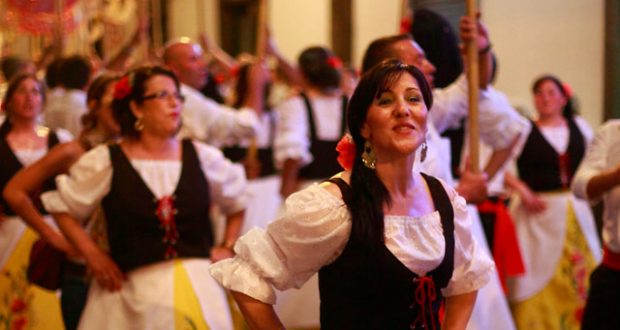
The São João Festival offers an intoxicating introduction to Porto and its native tipple, but no education in port would be complete without a journey upstream to the soulful quintas of Pinhão
View online at natgeotraveller.co.uk
In the growing heat of late morning, as I venture outdoors into the steep, twisting lanes of Ribeira, I’m having a hard time separating memories from dreams. It seems unlikely — fantastical, even — that last night every man, woman and child in Porto roamed this neighbourhood, cheerfully hitting each other on the head with squeaky plastic hammers. But that’s precisely what happened.
There’s no other party quite like the Festa de São João — in part, because Porto’s massive midsummer celebration remains a relatively local affair. On 23 June each year, Tripeiros (‘tripe eaters’, as Porto’s citizens call themselves) arm themselves with martelos and get into the spirit of walloping passers-by, a tradition derived from an old courtship ritual. I can reveal it’s excellent fun, although I’m paying the price today. There’s a violent pounding in my skull and I know the culprits: the hammers, yes, but also port.
São João is about Porto celebrating Porto — its heritage, its irreverent spirit. And a large part of the city’s identity is wound up in its most famous export: port wine. In among the festival’s sprawling encampment of rustic grills, their heat, heady smells and wafting smoke, I’d found makeshift bars laden with assorted bottles of the stuff, sold by the cup for €3. It had a complex taste, as sweet as dark berries, and was very moreish.
My morning wander takes me across the Dom Luís I Bridge to Vila Nova de Gaia, the district of old port houses and riverfront restaurants. I just have time to push around a serving of flappy tripe and beans (I’m not quite a Tripeiro yet) before there’s a commotion on the riverbank. Those of us who have made it out of bed are rewarded by the sight of a dozen or so old-fashioned barges charging along the Douro, each flying a sail emblazoned with the motif of a major port house.
This is the Regata de Barcos Rabelos, the final flourish of the São João Festival. The race harks back to the 19th and early 20th centuries, when wine barrels were still shipped from the vineyards of the Douro Valley to age in the cool cellars of Porto. Everyone on the bank has picked a team to root for. But it’s not a graceful contest: the wind (or perhaps the crews’ hangovers) sends the boats careening into each other like a whimsical version of bumper cars. When one finally breaks free from the fray and passes under the bridge, there’s raucous cheering and a man in folksy traditional get up — I imagine he must be the mayor — darts off with his retinue to greet the winning crew.
It’s my cue to head for the train station. My visit to Porto was but an aperitif to my real education in port. A picturesque train journey takes me into the Douro Valley and to Pinhão, home to one of the world’s oldest and most intriguing port wine estates, Quinta do Noval.
A half-hour, winding drive from the tiny station and the Noval estate comes into view: a white manor house set high on the slopes of a dramatic valley. Terraces trace the undulating contours of the land. A donkey and two farmhands labour among the vines, but otherwise the scene is still and the only noise is birdsong. Even with rain clouds gathering overhead, it’s ridiculously idyllic. Anna, my host, hits upon a theory as we take a tour: “Very often, great wines come from very pretty places.” Perhaps there’s a direct correlation, I suggest; I’d be very willing to conduct the research.
We climb the terraces behind the house. The air smells of wet slate and musty earth. “This is it. Nacional.” Anna announces grandly. It’s what I’ve come to see, but doesn’t look like much — a small plot of vines, some five acres in total. But in the history of wine, it’s the site of a miracle. When the phylloxera bug decimated Europe’s vineyards in late 19th century, crippling the Douro Valley, this parcel of land continued to thrive. “We don’t know why,” Anna concedes. “There’s a mystery to this soil. The rhythms here don’t follow the rest of the vineyard.” Elsewhere, vines had to be replanted on resistant rootstocks from America; but not Nacional. Today, it’s producing some of the world’s most highly prized port.
At dinner, after various candle-lit courses, a bottle of the 2010 Nacional Vintage Port is opened. As Anna lists its flavours, my novice palette recognises them too. Dark fruits, eucalyptus, cedar. I suggest chocolate, too, and it turns out there are no wrong answers.
It seems unnatural that I’ve reached the pinnacle of my port wine tasting career so quickly — from nameless port in a party cup to a famous, rare vintage in 24 hours — especially because time and patience seem to be important players at Quinta do Noval. It’s a place to grow and age, and not just for grapes and wine. Maria, the cook, has been working here for more than 40 years. José, the 87-year-old cooper, still comes to the quinta every day, despite officially being retired. And Anna tells me there have been ghost sightings in one of the top bedrooms, which I take as further evidence of the leisurely pace of things. Someone’s just taking their time to depart.
When a storm suddenly breaks over the valley, with raindrops the size of almonds barraging the French windows, I take my cue from the phantom upstairs and nestle a little deeper into my chair. There’s still half a bottle to go.
More info: quintadonoval.com











